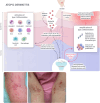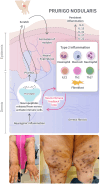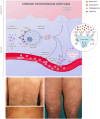Type 2 Inflammation and Its Role in Dermatologic Diseases
- PMID: 40119613
- PMCID: PMC12082622
- DOI: 10.1111/ijd.17707
Type 2 Inflammation and Its Role in Dermatologic Diseases
Abstract
Atopic dermatitis, prurigo nodularis, and chronic spontaneous urticaria are immune-mediated, inflammatory skin conditions characterized by intense itch and disease-specific skin lesions. Despite their different clinical presentations, the three diseases are unified by an aberrant type 2 immune response involving type 2 cytokines, immune cells, and sensory nerves that may underlie their shared clinical manifestations of inflammation and pruritus. The chronic nature of these conditions is associated with significant impairment in patients' quality of life and psychological disorders, such as anxiety and depression. This article reviews type 2 inflammation and its role in atopic dermatitis, prurigo nodularis, and chronic spontaneous urticaria, focusing on the pathophysiologic drivers of type 2 inflammation in each dermatologic condition. Understanding the shared immune mechanisms that underlie these seemingly distinct skin diseases and other concomitant inflammatory conditions is critical for applying therapeutic interventions targeting the type 2 immune pathway.
Keywords: atopic dermatitis; chronic spontaneous urticaria; cytokine; prurigo nodularis; type 2 inflammation.
© 2025 The Author(s). International Journal of Dermatology published by Wiley Periodicals LLC on behalf of the International Society of Dermatology.
Conflict of interest statement
Raj Chovatiya has served as an advisor, consultant, speaker, and/or investigator for AbbVie, Amgen, Apogee Therapeutics, Arcutis Biotherapeutics, Argenx, Aslan Pharmaceuticals, Beiersdorf, Boehringer Ingelheim, Bristol Myers Squibb, Cara Therapeutics, Dermavant, Eli Lilly, FIDE, Formation Bio, Galderma, Genentech, GSK, Incyte, L'Oréal, LEO Pharma, Nektar Therapeutics, Novartis, Opsidio, Pfizer, RAPT Therapeutics, Regeneron Pharmaceuticals Inc., Sanofi, Sitryx, and UCB. Jason Hawkes has served as an advisor, consultant, speaker, medical board member, and/or counselor for Apogee Therapeutics, Arcutis Biotherapeutics, Boehringer Ingelheim, Blueprint Medicines, Bristol Myers Squibb, Boxer Capital LLC, Galderma, Institute for Systems Biology (ISB), International Psoriasis Council, Janssen, LEO Pharma, National Psoriasis Foundation, Novartis, Pfizer, Regeneron Pharmaceuticals Inc., Sanofi, Sun Pharma, Takeda, and UCB. Douglas DiRuggiero has served as an advisor, consultant, and/or speaker for AbbVie, Amgen, Arcutis Biotherapeutics, Boehringer Ingelheim, Bristol Myers Squibb, Dermavant, Eli Lilly, Galderma, Incyte, Janssen, LEO Pharma, Medscape, National Psoriasis Foundation, Novartis, Pfizer, Regeneron Pharmaceuticals Inc., Sanofi, UCB, and WebMD. Leigh Ann Pansch has served as an advisor, consultant, and/or speaker for AbbVie, Arcutis Biotherapeutics, Beiersdorf, Boehringer Ingelheim, Bristol Myers Squibb, Dermavant, Eli Lilly, Galderma, Johnson & Johnson, LEO Pharma, Novartis, Pfizer, Regeneron Pharmaceuticals Inc., Sanofi, and UCB. Elizabeth Simcox is an employee and shareholder of Regeneron Pharmaceuticals Inc. Tayler Gonzalez is an employee of and may hold stock and/or stock options in Sanofi.
Figures




References
-
- Annunziato F., Romagnani C., and Romagnani S., “The 3 Major Types of Innate and Adaptive Cell‐Mediated Effector Immunity,” Journal of Allergy and Clinical Immunology 135, no. 3 (2015): 626–635. - PubMed
Publication types
MeSH terms
Substances
Grants and funding
LinkOut - more resources
Full Text Sources
Medical
Research Materials

